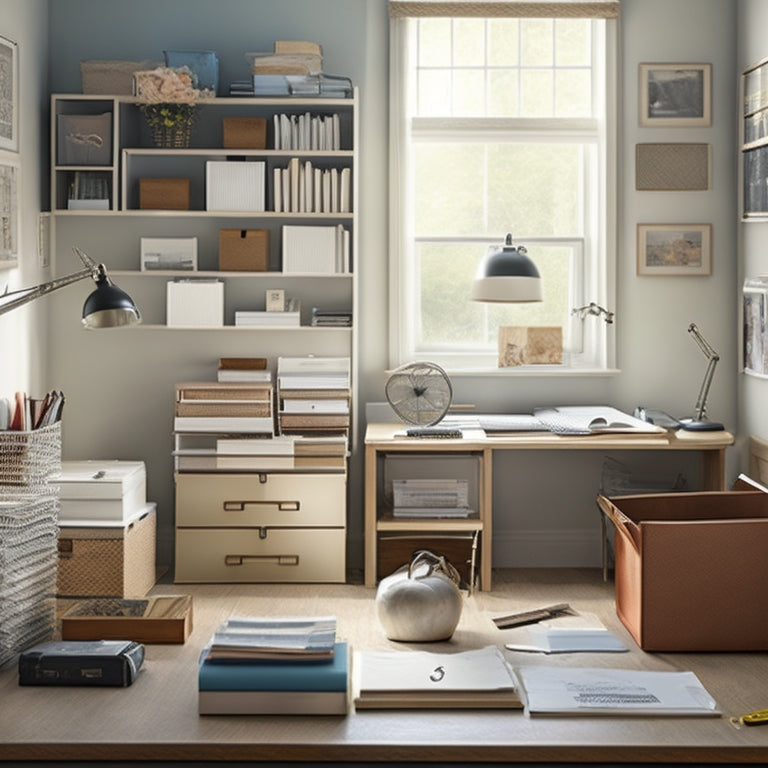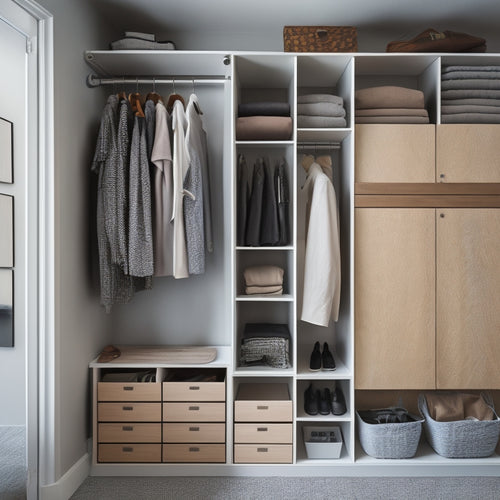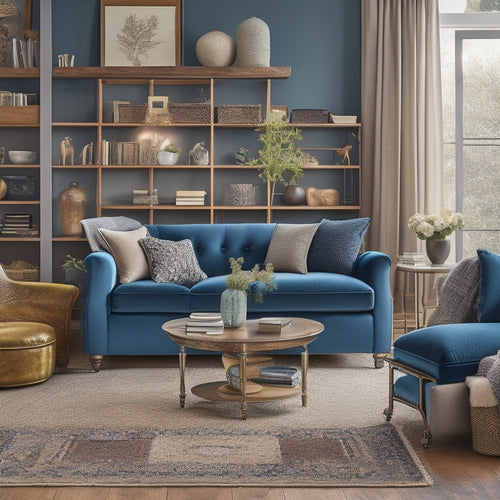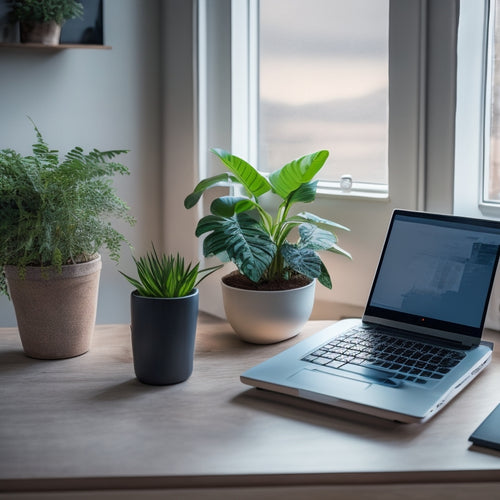
Declutter Your Home Office on a Shoestring Budget
Share
You can transform your cluttered home office into a productive and organized space without breaking the bank. Start by clearing everything out and beginning with a blank slate. Next, purge unwanted office items, categorize and group similar items, and assign a home for each item. Utilize vertical storage spaces to maximize your area. By repurposing old furniture creatively and investing in multifunctional tools, you can create a functional workstation. Establish a maintenance routine to keep your space organized. By following these steps, you'll be well on your way to a clutter-free home office - and there are even more cost-effective strategies to explore ahead.
Key Takeaways
• Start with a blank slate by purging unwanted office items like broken or outdated equipment to create a fresh start.
• Repurpose old furniture creatively for specific functions to transform your workspace without breaking the bank.
• Utilize vertical storage spaces with shelf dividers and wall organizers to maximize storage without additional costs.
• Implement a color-coding system for easy identification and categorize similar items based on function for efficient organization.
• Establish a maintenance routine for weekly upkeep to prevent clutter buildup and ensure a consistently organized workspace.
Start With a Blank Slate
Begin by clearing everything out of your home office, leaving nothing but an empty room or a bare desk, so you can assess the space and start fresh. This step is vital in achieving mental clarity and a sense of control over your workspace.
A clutter-free environment allows you to think more clearly and focus on what's essential. Imagine your empty room or desk as a fresh canvas, waiting for you to create a productive and organized space that reflects your work style.
Take a moment to walk around the room, notice the natural light, and think about how you want to utilize the space. Consider the tasks you'll be performing, the equipment you need, and the type of storage that will keep your office supplies organized.
With a blank slate, you can design a workspace that boosts your productivity and efficiency. By starting from scratch, you'll be able to create a home office that truly works for you, rather than against you.
Purge Unwanted Office Items
Now that you've cleared the space, it's time to tackle the unwanted items. You'll want to get rid of anything that's broken, outdated, or simply taking up space, so grab a trash bag and start tossing.
Next, sort the remaining items into categories, like 'keep,' 'donate,' and 'recycle,' to make the most of your purge.
Toss the Trash Now
Get rid of broken or outdated office equipment, such as that jammed printer or VHS player, to free up valuable space and reduce distractions. You'll be surprised at how much more focused you'll be without those clunky machines taking up space.
Next, tackle the paper clutter. Go through your files and sort them into three piles: keep, scan, and shred. Be ruthless – if you don't need it, get rid of it. Consider going paperless to reap benefits like reduced storage needs and easier access to important documents.
Create digital archives of your important files and store them securely in the cloud. This won't only declutter your physical space but also give you peace of mind knowing your files are safe and easily accessible.
Sort and Categorize Items
Sort everything you've kept into categories, such as office supplies, paperwork, and electronics, to gain a clear understanding of what you're working with and make the organizing process more manageable. This will help you identify patterns, duplicates, and items that can be purged or repurposed.
Within each category, sort items further into subcategories, like 'writing supplies' or 'financial documents.' This will make it easier to find what you need when you need it.
To take your sorting to the next level, consider implementing a color-coding system. Use different colored labels or folders to categorize items, such as green for 'urgent' or blue for 'long-term projects.' This visual system will help you quickly identify what's important and what can wait.
Additionally, create a labeling system for your files and storage bins, so you can easily find what you're looking for. By sorting and categorizing your items, you'll be able to see what you have, what you need, and what you can get rid of, making it easier to declutter your home office on a shoestring budget.
Categorize and Group Similar Items
Categorize your office supplies, papers, and equipment into distinct groups based on their purpose or function to create a sense of order and make the most of your available space. This step is essential in decluttering your home office, as it allows you to see what you have, what you need, and what you can get rid of.
To effectively categorize and group similar items, use category labels and item bundles. Here's an example of how you can group similar items:
| Category Label | Item Bundles |
|---|---|
| Writing Utensils | Pens, Pencils, Markers, Highlighters |
| Paper Management | Notebooks, Binders, Folders, Paper Clips |
| Electronic Accessories | Cables, Chargers, Adapters, Headphones |
| Office Decor | Plants, Pictures, Rugs, Decorative Items |
Assign a Home for Each Item
Now that you've categorized and grouped similar items, it's time to assign a home for each item.
You'll want to designate a specific spot for each group, ensuring everything has a designated place to live.
Designate a Spot
Assign a home for each item in your office by designating a specific spot where it will be kept, making it easier to find what you need when you need it. This simple step will help you maintain your newly decluttered space.
Start by identifying the items you use most frequently and designate a focal point in your office for them. This could be a corner nook near your desk or a shelf within easy reach. Once you've designated a spot, make sure to return each item to its home after use. This habit will help you avoid clutter buildup in the future.
Be intentional about where you place each item, considering how often you use it and how much space it requires. For example, if you have a lot of paperwork to file, designate a spot near your filing cabinet for your paperwork basket.
Categorize and Group
By grouping similar items together, you'll create a sense of order and make it easier to find what you need, so start by categorizing your office supplies, paperwork, and equipment into distinct categories. This will help you visualize what you have and where it should go.
Create labels or folders for each category, and consider using color coding to differentiate between types of items. For example, use blue labels for paperwork and red for office supplies.
Once you've categorized your items, assign a home for each one. This means designating a specific spot for each item, making it easy to find and access when you need it. Implement productivity hacks like storing frequently used items in easy-to-reach locations and keeping less-used items on higher or lower shelves.
By doing so, you'll save time and reduce frustration when searching for something. Remember, the goal is to create a system that works for you, so experiment and adjust as needed.
With a categorized and organized system, you'll be amazed at how much more efficiently you can work in your home office.
Utilize Vertical Storage Spaces
Maximize your home office's potential by capitalizing on often-overlooked vertical storage spaces that can help you efficiently store office supplies, files, and equipment. You can start by installing shelf dividers to separate and organize items on your existing shelves. This will help prevent clutter from building up and make it easier to find what you need.
Next, consider investing in wall organizers such as hooks, baskets, or boards to take advantage of the vertical space on your walls. These can be used to hang items like bags, jackets, or accessories, or to store office supplies like papers, folders, and writing utensils.
You can also use wall-mounted shelves or racks to store books, binders, or other office materials.
Repurpose Old Furniture Creatively
You can breathe new life into old furniture by repurposing it to serve a specific function in your home office, such as converting an outdated bookshelf into a storage unit for office supplies. This furniture revival technique not only saves you money but also reduces waste and adds a touch of creativity to your space.
Consider turning an old desk into a standing desk or a file organizer. You can also repurpose an old dresser into a storage unit for paperwork or office equipment. By thinking outside the box, you can create a functional and organized home office without breaking the bank.
Space hacking is all about maximizing your available space, and repurposing old furniture is a key aspect of it. Get creative and think about how you can reuse old furniture to create a more efficient and productive workspace.
With a little bit of imagination and elbow grease, you can turn your old furniture into functional pieces that will help you stay organized and focused. So, don't throw away that old furniture just yet – give it a new life and make your home office a more functional and inspiring space.
Invest in Multifunctional Tools
Incorporating multifunctional tools into your home office setup can streamline your workflow, free up valuable space, and reduce clutter. You'll be amazed at how these Space Savers and Productivity Boosters can transform your workspace. By investing in tools that serve multiple purposes, you'll minimize the number of separate devices and gadgets taking up valuable real estate.
Here are some examples of multifunctional tools you can consider:
| Tool | Functions |
|---|---|
| All-in-one printer | Print, scan, copy, and fax |
| Desk lamp with USB ports | Provide task lighting and charge devices |
| Ergonomic keyboard with built-in touchpad | Type and navigate with ease |
| Whiteboard with built-in storage | Take notes and store office supplies |
| Adjustable standing desk converter | Switch between sitting and standing |
These tools are designed to help you work more efficiently and effectively, while also reducing the amount of clutter in your home office. By choosing multifunctional tools, you'll be able to accomplish more with less, and enjoy a more organized and productive workspace.
Create a Functional Workstation
How can you design a workstation that supports your workflow and boosts productivity, while keeping clutter at bay? Start by prioritizing an ergonomic layout. Position your chair, desk, and computer to promote good posture and reduce eye strain. This will help you stay focused and avoid distractions.
Next, tackle cable management. Use cable ties or a cord organizer to keep your workspace tidy and prevent tangles. This will save you time and reduce frustration. Consider investing in a desk with built-in cable management features or a cordless keyboard and mouse.
A clutter-free workstation will help you stay organized and focused. By implementing these simple strategies, you'll be able to work more efficiently and effectively.
Establish a Maintenance Routine
Your home office's organization is only as good as its maintenance, so set aside time each week to keep your space clutter-free and functional.
To do this, establish a daily review habit. Set a reminder to dedicate 10-15 minutes each day to tidying up your workspace. Go through your papers, files, and notes, and put away anything that's out of place. This daily review will help you stay on top of clutter and prevent it from building up.
In addition to your daily review, schedule a weekly reflection to assess your progress and make adjustments as needed. Take 30 minutes to an hour to review your tasks, goals, and habits. Ask yourself what's working and what areas need improvement.
Use this time to plan your upcoming week, set new goals, and make any necessary changes to your workflow. By incorporating these daily and weekly habits, you'll be able to maintain your organized home office and make sure it remains a productive and efficient space.
Frequently Asked Questions
How Do I Stay Motivated During the Decluttering Process?
You'll stay motivated by celebrating small breakthrough moments, treating yourself to personal rewards, and focusing on the benefits of a clutter-free space, like increased productivity and reduced stress, to keep you driven and committed.
Can I Donate or Sell My Used Office Furniture and Supplies?
You can donate or sell used office furniture and supplies, and even score tax deductions! Consider furniture appraisals to determine value, then donate to charity or sell through online marketplaces or local classifieds.
What if I Have Limited Floor Space for Storage?
If you're strapped for floor space, you'll need to think vertically and compactly. Install vertical shelves to maximize wall space, and use compact containers that can be easily stacked or hung to keep supplies organized and out of the way.
Are There Any Eco-Friendly Storage Solutions I Can Use?
Don't worry, you can still stay eco-friendly despite limited space. You're in luck! Repurposed crates and sustainable shelves are perfect eco-friendly storage solutions for you, providing a guilt-free way to organize your belongings without breaking the bank.
How Often Should I Declutter My Home Office to Maintain Organization?
You should declutter your home office regularly, incorporating it into your daily routine and scheduling a seasonal refresh every 3-4 months to maintain organization and maximize productivity.
Related Posts
-

7 Best Compact Closet Storage Ideas for Tiny Homes
You're looking for compact closet storage ideas to maximize your tiny home's space. Start by doubling your hanging sp...
-

What Makes the Best DIY Storage Ottoman?
When constructing your ideal DIY storage ottoman, consider essential features like color, size, upholstery, and compl...
-

Declutter Your Desk With These Online Tutorials
You're just one organized desk away from boosting your productivity, reducing stress, and achieving a sense of contro...


